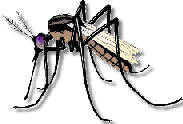ENTOMOLOGY 2040 |
 |
ENTOMOLOGY 2040 |
 |
LEARNING OBJECTIVES OF SECTION
After completing this section students should be able to:
Terms: Vector, Virus, mycoplasma, toxaemia, stylet-borne, circulative, Rickettsia, Bubonic plague, Lyme Disease, Rocky Mountain Spotted Fever, Trypanosomiasis, Onchocerciasis, Encephalitis, Arboviruses, Elephantiasis, Malaria, Tsetse fly.
1. Plant pathogens. In order of dependence upon vectors: Fungi--bacteria--viruses--mycoplasmas.
a. Fungi (most important plant pathogens).
b. Bacteria.
(1) Increase survival.
(2) Dissemination.
(3) Inoculation.
c. Viruses (second most important pathogens).
(1) Aphids.
(2) Leaf hoppers.
d. Mycoplasma-like organisms.
(1) Most dependent on vectors.
2. Animal pathogens.
a. Vectors. Most vectors are blood feeders.
(1) Diptera.
• Mosquitoes.
• Black flies.
• Sand flies.
• Tsetse flies.
(2) Other insects.
• Triatomid bugs.
• Fleas.
• Lice.
(3) Other arthropods.
• Ticks.
• Mites.
b. Diseases.
(1) Malaria--protozoa, Plasmodium.
• Vector--Anopheles sp. (species varies with location).
(2) Filariasis - elephantiasis.
• Non-lethal, traumatic symptoms.
• Vectors--many species, include Anopheles, Culex mosquitoes.
(3) Yellow fever (one of arboviruses).
• Many vectors--especially Aedes sp.
• Other viruses include encephalitis, WEE, EEE, ST. LV.
(4) Onchocerciasis (river blindness).
• Microfilaria-gradual infection, blindness, 20%, other--look old.
• Vector--black flies, Simulium sp.
(5) Trypanosomiasis (sleeping sickness).
• Trypanosomas, cause, sleep, coma, death.
• Vector--Tsetse flies.
c. Other vectors and primary diseases.
(1) Fleas - Black Plague or Bubonic Plague (bacteria).
(2) Lice - Typhus (Rickettsia).
(3) Ticks - Lyme Disease (bacteria).
• Rocky mountain spotted fever (Rickettsia).
STUDY QUESTIONS
| Return to Table of Contents |
Go to Section XV Pest Management